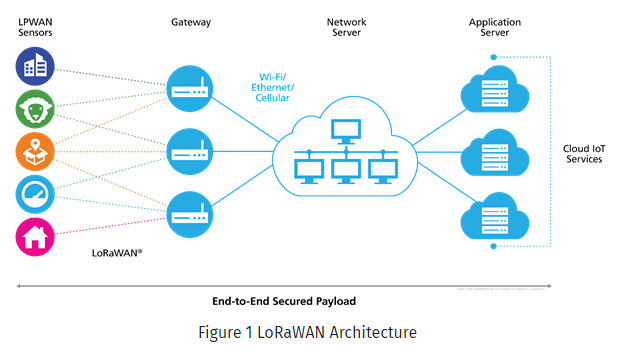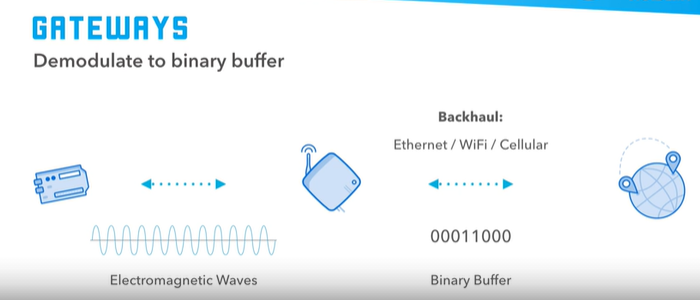- Home
- Symmetry Blog
- How to Select an Optimal LoRaWAN Gateway
How to Select an Optimal LoRaWAN Gateway | Symmetry Blog
About Savannah Cuthbert
.jpg)
LoRa®, short for long range, is a wireless radio frequency technology developed by Semtech. LoRa technology was developed to offer a low power and long-range solution for battery powered Internet of Things (IoT) devices. LoRa operates in an expansive global network; offering simple integration, high capacity, affordability, and the ability to connect devices in dense urban or deep indoor environments. Symmetry Electronics is a member of the LoRa Alliance®, a non-profit association of more than 500 member companies, committed to enabling large scale deployment of Low Power Wide Area Networks (LPWAN) through the development and promotion of the LoRaWAN® (Figure 1) open standard protocol.

Figure 1: LoRaWAN architecture
Source: Semtech
What is a LoRaWAN Gateway?
At the center of a LoRa deployment, is a LoRaWAN gateway (Figure 2). LoRaWAN gateways are routers that collect data from sensors and devices that then transfer the data (RF packets) over to a network server. Gateways do not read or interpret the data that is collected. Instead, they hold the data and send them to the cloud at a desired cadence. The cadence is determined by how often the end-device wakes up to send and receive data. Depending on the application, intermittent data transfers could be beneficial for best performance and efficiency. Conversely, an application like temperature monitoring could require a more consistent data transfer. A single LoRaWAN gateway is capable of supporting 1,000s of devices. However, factors like data rate and data packet size must be considered to ensure optimal performance. Large scale LoRaWAN deployments typically run on more than one gateway. Utilizing multiple gateways helps address harder to reach areas and adds a layer of resiliency in the event that a gateway fails.

Figure 2: Gateway diagram
Source: Semtech LoRaWAN Academy
Items to Consider When Selecting a LoRaWAN Gateway
There are a number of factors to consider when selecting the ideal gateway for your specific use case. In addition to the following, it is highly advised that a system undergoes extensive testing to ensure the best outcome:
- Application
- Indoor/Outdoor
- Field Coverage
- Data Transmission
- Capacity
- Backhaul
- Interoperability
- Security
- Budget
Public vs. Private LoRaWAN Networks
There are pros and cons to utilizing public or private LoRaWAN networks. However, depending on the application and desired outcomes, one option could be paramount to the other.
- Public Networks - For those seeking simplification and the ability to scale rapidly, a public network may be ideal for you. Public networks are able to handle mass amounts of data and offer extensive coverage in hard-to-reach places. This option is typically less costly than private networks, as it requires less infastrucucture from the user. A sophisticated public network offering is Helium’s The People’s Network, that offers a peer-to-peer wireless network that is incentivized via HNT cryptocurrency and protected by powerful Helium Blockchain technology.
- Private Networks - For those seeking more control and security, a private network option may be best for you. Although this method can be more complicated to install, private networks allow you to easily monitor traffic without having to rely on a third party. With control over gateway capacity, the user can increase system efficiency and ensure access to remote areas. Users also have the ability to utilize their own firmware to customize functionality. Additionally, this method allows for more flexibility for edge computing
Selecting Your LoRaWAN Gateway
Often used in applications like smart buildings, smart cities, smart homes, and industrial IoT (IIoT), LoRaWAN gateways are a crucial aspect of a LoRaWAN deployment. Users must consider important factors like data rate, data packet size, and other desired outcomes to ensure best performance and long-term interoperability. Testing prior to deployment is also highly advised to avoid costly re-designs. Consult with Symmetry Electronics’ knowledgeable Applications Engineers to determine which gateway is best for your application.
Featured LoRaWAN Gateway Solutions
- SigGateTM LoRa/Cellular IoT Gateway from Signetik
- MultiTech Conduit® IP67 Base Station from MultiTech
- Digi LoRaWAN Starter Kit from Digi International
Semtech, LoRa and the LoRa logo are registered trademarks or service marks, and LoRa Basics, LoRa Cloud and LoRa Edge are trademarks of service marks, of Semtech Corporation or its affiliates.
